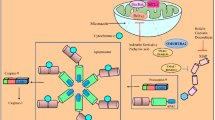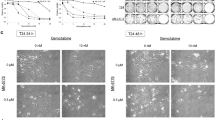Abstract
Bladder cancer (BC) is the most common cancer of the urinary tract. Bozepinib (BZP), a purine-derived molecule, is a potential compound for the treatment of cancer. Purinergic signaling consists of the activity of nucleosides and nucleotides present in the extracellular environment, modulating a variety of biological actions. In cancer, this signaling is mainly controlled by the enzymatic cascade involving the NTPDase/E-NPP family and ecto-5’-nucleotidase/CD73, which hydrolyze extracellular adenosine triphosphate (ATP) to adenosine (ADO). The aim of this work is to evaluate the activity of BZP in the purinergic system in BC cell lines and to compare its in vitro antitumor activity with cisplatin, a chemotherapeutic drug widely used in the treatment of BC. In this study, two different BC cell lines, grade 1 RT4 and the more aggressive grade 3 T24, were used along with a human fibroblast cell line MRC-5, a cell used to predict the selectivity index (SI). BZP shows strong antitumor activity, with notable IC50 values (8.7 ± 0.9 µM for RT4; 6.7 ± 0.7 µM for T24), far from the SI for cisplatin (SI for BZP: 19.7 and 25.7 for RT4 and T24, respectively; SI for cisplatin: 1.7 for T24). BZP arrests T24 cells in the G2/M phase of the cell cycle, inducing early apoptosis. Moreover, BZP increases ATP and ADP hydrolysis and gene/protein expression of the NPP1 enzyme in the T24 cell line. In conclusion, BZP shows superior activity compared to cisplatin against BC cell lines in vitro.



Similar content being viewed by others
Data availability
All data are available upon reasonable request.
References
Saginala K, Barsouk A, Aluru JS et al (2020) Epidemiology of Bladder Cancer. Med Sci (Basel) 8. https://doi.org/10.3390/medsci8010015
Kogevinas M, Mannetje ’T, Cordier A S, et al (2003) Occupation and Bladder cancer among men in Western Europe. Cancer Causes Control 14:907–914. https://doi.org/10.1023/B:CACO.0000007962.19066.9c
Bray F, Ferlay J, Soerjomataram I et al (2018) Global cancer statistics 2018: GLOBOCAN estimates of incidence and mortality worldwide for 36 cancers in 185 countries. CA Cancer J Clin 68:394–424. https://doi.org/10.3322/caac.21492
Mushtaq J, Thurairaja R, Nair R (2019) Bladder cancer. Surg (United Kingdom) 37:529–537. https://doi.org/10.1016/j.mpsur.2019.07.003
Bellmunt J, Orsola A, Leow JJ et al (2014) Bladder cancer: ESMO practice guidelines for diagnosis, treatment and follow-up. Ann Oncol 25:iii40–iii48. https://doi.org/10.1093/annonc/mdu223
DeGeorge KC, Holt HR, Hodges SC (2017) Bladder Cancer: diagnosis and treatment. Am Fam Physician 96:507–514
Lotan Y, Kamat AM, Porter MP et al (2009) Key concerns about the current state of Bladder cancer: a position paper from the Bladder Cancer think Tank, the Bladder Cancer Advocacy Network, and the Society of Urologic Oncology. Cancer 115:4096–4103. https://doi.org/10.1002/cncr.24463
Chang SS, Bochner BH, Chou R et al (2017) Treatment of non-metastatic muscle-invasive Bladder Cancer: AUA/ASCO/ASTRO/SUO Guideline. J Urol 198:552–559. https://doi.org/10.1016/j.juro.2017.04.086
Martinez Rodriguez RH, Buisan Rueda O, Ibarz L (2017) Bladder cancer: Present and future. Med Clin (Barc) 149:449–455. https://doi.org/10.1016/j.medcli.2017.06.009
Dias A, de Scholl F, Moritz JN CEJ, et al (2021) New insights into cytotoxic mechanisms of bozepinib against glioblastoma. Eur J Pharm Sci 162. https://doi.org/10.1016/j.ejps.2021.105823
Ramírez A, Boulaiz H, Morata-Tarifa C et al (2014) HER2-signaling pathway, JNK and ERKs kinases, and cancer stem-like cells are targets of Bozepinib small compound. Oncotarget 5:3590–3606. https://doi.org/10.18632/oncotarget.1962
Marchal JA, Carrasco E, Ramirez A et al (2013) Bozepinib, a novel small antitumor agent, induces PKR-mediated apoptosis and synergizes with IFNα triggering apoptosis, autophagy and senescence. Drug Des Devel Ther 7:1301–1313. https://doi.org/10.2147/DDDT.S51354
Kim SH, Choi JY (2022) Purinergic signaling in the peripheral vestibular system. Purinergic Signal 18:165–176. https://doi.org/10.1007/s11302-022-09855-5
Zimmermann H, Zebisch M, Sträter N (2012) Cellular function and molecular structure of ecto-nucleotidases. Purinergic Signal 8:437–502. https://doi.org/10.1007/s11302-012-9309-4
Colgan SP, Eltzschig HK, Eckle T, Thompson LF (2006) Physiological roles for ecto-5’-nucleotidase (CD73). Purinergic Signal 2:351–360. https://doi.org/10.1007/s11302-005-5302-5
Reyna-Jeldes M, Díaz-Muñoz M, Madariaga JA et al (2021) Autocrine and paracrine purinergic signaling in the most lethal types of cancer. Purinergic Signal 17:345–370. https://doi.org/10.1007/s11302-021-09785-8
Campos-Contreras ADR, Díaz-Muñoz M, Vázquez-Cuevas FG (2020) Purinergic Signaling in the hallmarks of Cancer. Cells 9:1–24. https://doi.org/10.3390/cells9071612
Burnstock G, Di Virgilio F (2013) Purinergic signalling and cancer. Purinergic Signal 9:491–540. https://doi.org/10.1007/s11302-013-9372-5
Stella J, Bavaresco L, Braganhol E et al (2010) Differential ectonucleotidase expression in human Bladder cancer cell lines. Urologic Oncology: Seminars and Original Investigations 28:260–267. https://doi.org/10.1016/j.urolonc.2009.01.035
Rockenbach L, Braganhol E, Dietrich F et al (2014) NTPDase3 and ecto-5’-nucleotidase/CD73 are differentially expressed during mouse Bladder cancer progression. Purinergic Signal 10:421–430. https://doi.org/10.1007/s11302-014-9405-8
Nunez M, Diaz-Gavilan M, Conejo-Garcia A et al (2008) Design, synthesis and anticancer activity against the MCF-7 cell line of Benzo-fused 1,4-Dihetero seven- and six-Membered Tethered pyrimidines and purines. Curr Med Chem 15:2614–2631. https://doi.org/10.2174/092986708785909021
Figueiró F, Bernardi A, Frozza RL et al (2013) Resveratrol-loaded lipid-core nanocapsules treatment reduces in vitro and in vivo glioma growth. J Biomed Nanotechnol 9:516–526. https://doi.org/10.1166/jbn.2013.1547
Chan K-M, Delfert D, Junger KD (1986) A direct colorimetric assay for Ca2+-stimulated ATPase activity. Anal Biochem 157:375–380. https://doi.org/10.1016/0003-2697(86)90640-8
Bradford MM (1976) A rapid and sensitive method for the quantitation of microgram quantities of protein utilizing the principle of protein-dye binding. Anal Biochem 72:248–254. https://doi.org/10.1016/0003-2697(76)90527-3
Schmittgen TD, Livak KJ (2008) Analyzing real-time PCR data by the comparative CT method. Nat Protoc 3:1101–1108. https://doi.org/10.1038/nprot.2008.73
Xu J, Gewirtz DA (2022) Is autophagy always a barrier to Cisplatin. Therapy? Biomolecules 12:1–22. https://doi.org/10.3390/biom12030463
Sun C, Mezzadra R, Schumacher TN (2018) Regulation and function of the PD-L1 checkpoint. Immunity 48:434–452. https://doi.org/10.1016/j.immuni.2018.03.014
Narayan VM (2021) Radiotherapy with or without chemotherapy in muscle-invasive Bladder Cancer. 50 studies every urologist should know. 147–152. https://doi.org/10.1093/med/9780190655341.003.0026
Torgovnick A, Schumacher B (2015) DNA repair mechanisms in cancer development and therapy. Front Genet 6:1–15. https://doi.org/10.3389/fgene.2015.00157
Choi W, Porten S, Kim S et al (2014) Identification of distinct basal and luminal subtypes of muscle-invasive Bladder Cancer with different sensitivities to Frontline Chemotherapy. Cancer Cell 25:152–165. https://doi.org/10.1016/j.ccr.2014.01.009
Jiang DM, Gupta S, Kitchlu A et al (2021) Defining cisplatin eligibility in patients with muscle-invasive Bladder cancer. Nat Rev Urol 18:104–114. https://doi.org/10.1038/s41585-020-00404-6
Muller PY, Milton MN (2012) The determination and interpretation of the therapeutic index in drug development. Nat Rev Drug Discov 11:751–761. https://doi.org/10.1038/nrd3801
Awang N, Aziz ZA, Kamaludin NF, Chan KM (2014) Cytotoxicity and mode of cell death induced by triphenyltin (IV) compounds in vitro. Online J Biol Sci 14:84–93. https://doi.org/10.3844/ojbsci.2014.84.93
Badisa RB, Darling-Reed SF, Joseph P et al (2009) Selective cytotoxic activities of two novel synthetic Drugs on human breast carcinoma MCF-7 cells. Anticancer Res 29:2993–2996
Quispe MA, Zavala CD, Rojas CJ et al (2006) Efecto citotóxico selectivo in vitro de muricin H (acetogenina de Annona muricata) en cultivos celulares de cáncer de pulmón. Rev Peru Med Exp Salud Publica 23:265–269
“Pedro Kourí.” Instituto de Medicina Tropical, del Barrio Alonso S, Gutiérrez Gaitén G (1966) Y, Morier Díaz L Revista cubana de medicina tropical. Editorial Ciencias Médicas
Powles T, Perry J, Shamash J et al (2007) A comparison of the platinum analogues in Bladder cancer cell lines. Urol Int 79:67–72. https://doi.org/10.1159/000102917
Rahman NA, Yazan LS, Wibowo A et al (2016) Induction of apoptosis and G2/M arrest by ampelopsin E from Dryobalanops towards triple negative Breast cancer cells, MDA-MB-231. BMC Complement Altern Med 16:1–9. https://doi.org/10.1186/s12906-016-1328-1
Li B, Zhou P, Xu K et al (2020) Metformin induces cell cycle arrest, apoptosis and autophagy through ROS/JNK signaling pathway in human osteosarcoma. Int J Biol Sci 16:74–84. https://doi.org/10.7150/ijbs.33787
Bhosale PB, Abusaliya A, Kim HH et al (2022) Apigetrin promotes TNFα-Induced apoptosis, Necroptosis, G2/M phase cell cycle arrest, and ROS Generation through Inhibition of NF-κB pathway in Hep3B Liver Cancer cells. https://doi.org/10.3390/cells11172734. Cells 11:
Qu K, Lin T, Wei J et al (2013) Cisplatin induces cell cycle arrest and senescence via upregulating P53 and P21 expression in HepG2 cells. Nan Fang Yi Ke Da Xue Xue Bao 33:1253–1259
Wang S, Li W, Xue Z et al (2013) Molecular imaging of p53 signal pathway in Lung cancer cell cycle arrest induced by cisplatin. Mol Carcinog 52:900–907. https://doi.org/10.1002/mc.21930
Magnano S, Hannon Barroeta P, Duffy R et al (2021) Cisplatin induces autophagy-associated apoptosis in human oral squamous cell carcinoma (OSCC) mediated in part through reactive oxygen species. Toxicol Appl Pharmacol 427:115646. https://doi.org/10.1016/j.taap.2021.115646
Li QQ, Lee RX, Liang H et al (2013) Enhancement of cisplatin-induced apoptosis by β-elemene in resistant human Ovarian cancer cells. Med Oncol 30. https://doi.org/10.1007/s12032-012-0424-4
Park H-J, Kim J-S, Lee R, Song H (2022) Cisplatin induces apoptosis in mouse neonatal testes Organ Culture. Int J Mol Sci 23:13360. https://doi.org/10.3390/ijms232113360
Xu X, Lai Y, Hua Z-C (2019) Apoptosis and apoptotic body: Disease message and therapeutic target potentials. Biosci Rep 39. https://doi.org/10.1042/BSR20180992
Li YJ, Lei YH, Yao N et al (2017) Autophagy and multidrug resistance in cancer. Chin J Cancer 36:52. https://doi.org/10.1186/s40880-017-0219-2
Buchser WJ, Laskow TC, Pavlik PJ et al (2012) Cell-mediated autophagy promotes cancer cell survival. Cancer Res 72:2970–2979. https://doi.org/10.1158/0008-5472.CAN-11-3396
Amaravadi R, Kimmelman AC, White E (2016) Recent insights into the function of autophagy in cancer. Genes Dev 30:1913–1930. https://doi.org/10.1101/gad.287524.116
Panda PK, Mukhopadhyay S, Das DN et al (2015) Mechanism of autophagic regulation in carcinogenesis and cancer therapeutics. Semin Cell Dev Biol 39:43–55. https://doi.org/10.1016/j.semcdb.2015.02.013
González-Polo RA, Boya P, Pauleau AL et al (2005) The apoptosis/autophagy paradox: autophagic vacuolization before apoptotic death. J Cell Sci 118:3091–3102. https://doi.org/10.1242/jcs.02447
Trybus W, Król T, Trybus E, Stachurska A (2021) Physcion induces potential Anticancer effects in Cervical Cancer cells. https://doi.org/10.3390/cells10082029. Cells 10:
Shen X, Zhao B (2018) Efficacy of PD-1 or PD-L1 inhibitors and PD-L1 expression status in cancer: Meta-analysis. BMJ (Online) 362:1–9. https://doi.org/10.1136/bmj.k3529
Wu Y, Chen W, Xu ZP, Gu W (2019) PD-L1 distribution and perspective for cancer immunotherapy— blockade, knockdown, or inhibition. Front Immunol 10. https://doi.org/10.3389/fimmu.2019.02022
de Jong FC, Rutten VC, Zuiverloon TCM, Theodorescu D (2021) Improving anti-pd-1/pd-l1 therapy for localized Bladder cancer. Int J Mol Sci 22:1–15. https://doi.org/10.3390/ijms22062800
Soleimani A, Dadjoo P, Avan A et al (2022) Emerging roles of CD133 in the treatment of gastric cancer, a novel stem cell biomarker and beyond. Life Sci 293:120050. https://doi.org/10.1016/j.lfs.2021.120050
Ren F, Sheng WQ, Du X (2013) CD133: a cancer stem cells marker, is used in colorectal cancers. World J Gastroenterol 19:2603–2611. https://doi.org/10.3748/wjg.v19.i17.2603
Zhang JL, Liu Y, Yang H et al (2017) ATP-P2Y2-β-catenin axis promotes cell invasion in Breast cancer cells. Cancer Sci 108:1318–1327. https://doi.org/10.1111/cas.13273
Xia J, Yu X, Tang L et al (2015) P2X7 receptor stimulates breast cancer cell invasion and migration via the AKT pathway. Oncol Rep 34:103–110. https://doi.org/10.3892/or.2015.3979
Takai E, Tsukimoto M, Harada H, Kojima S (2014) Autocrine signaling via release of ATP and activation of P2X7 receptor influences motile activity of human lung cancer cells. Purinergic Signal 10:487–497. https://doi.org/10.1007/s11302-014-9411-x
Schulien I, Hockenjos B, Van Marck V et al (2020) Extracellular ATP and purinergic P2Y2 receptor signaling promote liver tumorigenesis in mice by exacerbating DNA damage. Cancer Res 80:699–708. https://doi.org/10.1158/0008-5472.CAN-19-1909
Acknowledgements
This study was supported by Conselho Nacional de Desenvolvimento Científico e Tecnológico (CNPq/PQ n°302879/2017-0, Battastini AM and CNPq n°406035/2021-0, CNPq/PQ n° 311580/2021-1, Figueiró F). J.S. received support from the Natural Sciences and Engineering Research Council of Canada (NSERC; RGPIN-2023-05498).
Author information
Authors and Affiliations
Contributions
Álisson C. da Silva: Methodology, investigation, writing-original draft preparation. Juliete N. Scholl, Amanda F. Dias and Augusto F. Weber: Investigation, data curation. Fernanda B. Morrone, Olga Cruz-López, Ana Conejo-García, and Jean Sévigny: Investigation. Joaquín María Campos: Investigation and writing-reviewing. Fabrício Figueiró and Ana M. O. Battastini: Supervision, writing-reviewing and editing, funding acquisition.
Corresponding author
Ethics declarations
Conflict of interest
The authors declare that they have no conflict of interest.
Competing interests
The authors declare no competing interests.
Additional information
Publisher’s Note
Springer Nature remains neutral with regard to jurisdictional claims in published maps and institutional affiliations.
Rights and permissions
Springer Nature or its licensor (e.g. a society or other partner) holds exclusive rights to this article under a publishing agreement with the author(s) or other rightsholder(s); author self-archiving of the accepted manuscript version of this article is solely governed by the terms of such publishing agreement and applicable law.
About this article
Cite this article
da Silva, Á.C., Scholl, J.N., de Fraga Dias, A. et al. Preclinical evaluation of bozepinib in bladder cancer cell lines: modulation of the NPP1 enzyme . Purinergic Signalling (2023). https://doi.org/10.1007/s11302-023-09975-6
Received:
Accepted:
Published:
DOI: https://doi.org/10.1007/s11302-023-09975-6




